Glacier National Park is the southern, US section of the conjoined US-Canadian Glacier-Waterton park, which spills across northern Montana and southern Alberta.
It would be hard to top the Wind River Range for pure north American wilderness beauty – but the rugged mountains and crystal blue lakes of Glacier National Park come close. Glacier seems more famed, though, for the rather prolific populations of bears – both black and grizzly – highlighted by the tragic death of a mountain biker a couple of weeks before our visit, who had had the severe misfortune of rounding a corner and riding directly into a grizzly who was crossing the path.
We were keen to tackle the Northern Traverse – a 70 mile hike on good trails over 4 days that – unsurprisingly – traverses the northern-most section of Glacier.
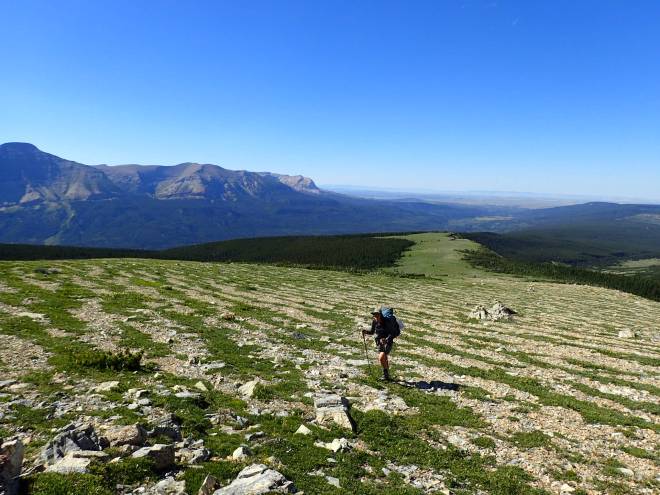
Day 1 – Chief Mountain to Slide Lake
We arrived at the St Mary visitor centre in Glacier mid-morning seeking permits for our intended route. Our first six choices for campground on the first night were unavailable so we settled on our seventh pick – a slight deviation from our intended route to Slide Lake, requiring a double-crossing of Gable Pass.
Despite its brevity, our permit took quite some time to acquire as old Fred the post-retirement-aged ranger wrestled with the computer keyboard, while his only-just-post-adolescent companion, ranger Mat, blithely surfed various websites searching for his next tattoo design. We waited anxiously, and then sat through the wilderness induction video, eyes on our watches as they ticked precariously close to the 12pm shuttle departure time that we needed to catch to the trailhead.
Finally, with 20 minutes to spare, we raced out of the visitors centre, packed our bags with lightening speed and were en route to the Chief Mountain trailhead, a 2-hour ride north. The block-shaped prominence of Chief Mountain greeted us there, rising high above the northern plains, is sacred to the Blackfoot tribe, and provides a notable landmark for hikers and climbers.
Our hike began on a well-worn trail through coniferous forest blanketing the lower reaches of Lee Ridge. After a couple of hours we broke out of the forest, following rock cairns up the open spine of the ridge. Having just climbed 1000 metres we hesitated about descending from Gable Pass – we were feeling the effects of the altitude and didn’t enjoy the prospect of having to climb back to where we were standing the following morning. After several minutes of debate we decided to descend – and were so glad we did! The wildflowers were absolutely spectacular – the best we’d seen yet! Within an hour we had spied Slide Lake through the trees and found ourselves a gorgeous secluded campsite.
Day 2 – Slide Lake to Mokowanis Junction
It took less than an hour to scramble back up to Gable pass the following morning. By the time we reached the top the sun was belting down and we were glad to be descending to the Belly River for the remainder of the morning. Once in the valley, we spied a sign for a short detour to Gros Ventre falls – and were delighted to find a surprisingly broad and picturesque waterfall, with a crystal blue swimming hole at its base. We ventured into the glacial water for a skinny dip, lunched, then launched ourselves up the valley past a series of large, blue lakes to Mokowanis. Along the way, we tiptoed around substantial amounts of bear scat, whilst nervously casting glances at the skies above as the roar of approaching thunder and the grey clouds crowded in.
Within half an hour thumbnail-sized hailstones were pelting us. The forest canopy was protecting us somewhat from the full force of the hailstorm but still we felt the wet and the cold after such a hot walk under the searing morning sun.
Fortunately the hailstorm was short-lived, although the sky remained overcast. Mist could be seen high in the valley to the west – the picturesque valley of waterfalls leading to Stoney Indian Pass appeared to take on mystical – almost mythical – qualities.

We took a detour to Mokowanis Lake for dinner – to be regaled with close bear encounter tales from a friendly local we met there – before heading back to our campsite at the Junction, where we met an inspiring Washington State couple out hiking for 6 days with their 4 year old and 15 month old daughters. As their girls romped happily around the campsite, we gleaned a lot of tips and insights into taking toddlers into the wilderness, including biodegradable nappies, treasure maps and plentiful supplies of bribes chocolate.
Day 3 – Mokowanis Junction to Francis Lake
We began the ‘climb’ to Stoney Indian Pass just before 8am. Long, low-gradient switchbacks through knee-deep foliage dripping with morning dew dominated the next two hours of hiking, and we enjoyed the climb in cool weather up toward the plateau…

Numerous waterfalls cascaded down the giant walls of the amphitheater that surrounded us. Paiota Falls and Atsina Falls tumbled down the sheer rock face into the turquoise Atsina Lake, and the melting snows of the Shepard Glacier enrobed the eastern flank of Cathedral Peak ahead of us. At one point the heavy river flows required a barefoot crossing of the icy water.
Angie and I stopped for a snack and to soak in the views at the top of Stoney Indian Pass, although to any casual onlooker, it must have looked more like an old-school slapstick pantomime. The mosquitoes were voracious, and for each bite of our muesli bars, it seemed that they got in at least five of us. We took it in turns to slap each other’s backs and limbs, competing for how many of these dastardly creatures we could kill with any one slap. Angie was by far the winner, collecting 5 mosquitoes in one, single slap to my back– or so she said…
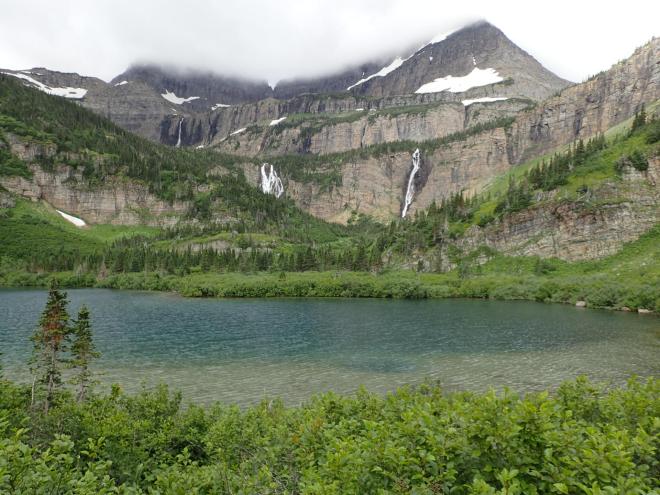
Descending slowly to Stoney Indian Lake, and then to the curiously named Goat Haunt, I wondered just how much longer Glacier National Park would keep its name… In the 1960s, there was clear evidence that the 150 glaciers known to have existed in the park a hundred years earlier had greatly retreated, and in many cases disappeared altogether. By 2010, 37 glaciers remained. If the current warming trend continues, all of the remaining glaciers in the park will be gone by 2030.
We arrived at the southern shore of Waterton Lake in the early afternoon, to be jolted out of our wilderness serenity by a gaggle of day tourists arriving by boat from Canada for half an hour’s jaunt on the US side of the lake. Undeterred, we sat on a park bench eating our tuna wraps just like Forrest Gump eating his box of chocolates, with our socks and shoes out to air and our bags disemboweled around us. By the end of our lunchtime the day tourists had departed and an inquisitive, albeit slightly anxious deer appeared on the sandy shore.
We turned west and headed up a bear-scat laden trail toward the beautiful Lake Francis – a sapphire blue pool of glacial melt hugged by giant vertical cliffs, embroidered with ribbon-like cascades. As luck would have it, it was to be our campsite for the night. A quick skinny-dip upon arrival gave us an indication of both the source and temperature of the water, and the frailties of the human condition. “If I can find it, I can wash it”, I said to Angie in a slightly too high-pitched voice.
Day 4 – Francis Lake to Kintla Lake
Leaving Francis Lake was tough – it was such a beautiful spot. With two passes ahead of us, we woke early to begin with an hour of uphill. The air was crisp and fresh, and dew clung to the knee-deep vegetation lining the trail. This brought us to Browns Pass and the beginning of a fantastic section of trail that traversed steep mountains and a picturesque alpine amphitheater before a final climb over the snow-encrusted Boulder Pass. We were absolutely stunned at how this trail had been carved into the side of the mountain – a narrow trail cut into the side of an otherwise nearly vertical cliff-face, providing access to the otherwise unreachable pass to the east.

At the head of the amphitheatre we snacked whilst admiring the splendid views of Thunderbird Mountain, Mount Custer and the myriad waterfalls and cliff faces surrounding us. We had to bypass a couple of patches of steep, slushy snow before scrambling up a series of rock benches – following large cairns – to the lunar-like crest of Boulder Pass.
The views from Boulder Pass to the west were only slightly less impressive. Striated, coloured rock dominated a high alpine basin where the heads of two valleys met. We lunched on a rocky ledge amongst marmots and squirrels before spending the remainder of the day walking in sunshine down through a pine and fir shaded valley to Kintla creek and the cerulean string of Kintla lakes.
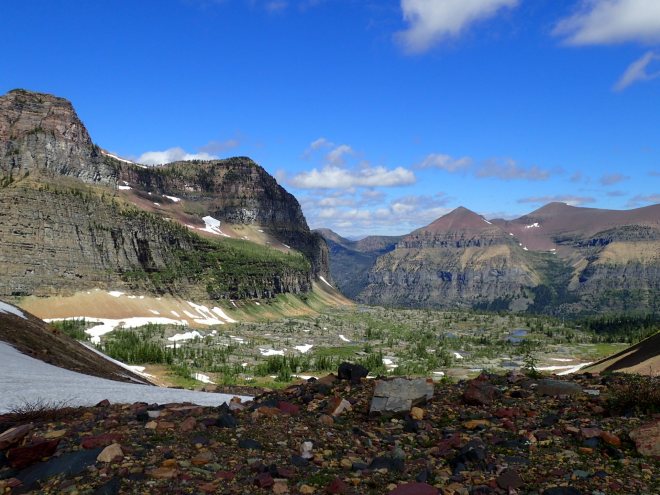
As we wandered along the lower-lying trail, the fiery-red centres of the flower-like berries beside the trail grabbed at our attention. They were the deepest of reds, and gleamed in such a way that it almost seemed they were crying out to be eaten. It was more than Angie could handle, and before I knew it, she had reached down to pick one, and was tentatively tasting it. Her love for foraging knows no bounds… to my relief, her eyes lit up, and she proclaimed it the most delicious berry she’d ever tasted. Soon, I was hip-deep in the bushes too, scrambling around for these little morsel’s of nature’s candy – which we later found out are thimbleberries (we also enjoyed plentiful snacks on the wild raspberries and huckleberries that grew along the way!).
By dusk we had bathed in the upper lake and settled into our camp clothes, happy but exhausted after a foot-shattering 20 mile day containing mort than its fair share of ups and downs.
Day 5 – Kintla Lake to Sherman
An easy stroll of a couple of hours along the shore of Kintla Lake took us back to the Kintla Lake trailhead – the end of our hike. There we learned that there is apparently no retirement age for Glacier park rangers. 96 year old Lyle Ruterbories, a seasonal park ranger welcomed us to back to civilization with his broad, kind smile.
We were offered a lift from the trailhead to the nearest shuttle station by Rhonda, a local Montanan we had met the previous evening at camp. She had been paddling the lake with her family. She was a wonderful, strong-hearted woman, who had moved to the region in her early twenties for its rugged wilderness and her love of climbing, hiking and kayaking – and had never wanted to leave.

Epilogue:
The byline for this story originates from the Going to the Sun road that bisects the lower reaches of Glacier NP. Construction of the 80 kilometre ‘Sun Road’ began in 1921 and was completed in 1932. It was, and still is, a civil engineering marvel – built for the sole purpose of attracting tourists to the park’s interior.
So later that day, having spent the searing hot afternoon travelling the Going to the Sun road in the air-conditioned comfort of a park shuttle bus, Angie and I enjoyed a pleasant dinner overlooking the glassy Two Medicine Lake.
We were driving out of the deserted parking lot – in the wrong direction as we soon discovered when we were stopped by a certain Ranger Griswold – a short statured but overly officious guardian of the park rules that looked like the love child of Chevy Chase and a chipmunk. Actually to be fair, he looked like Ned Flanders’ twin brother. After being ‘apprehended’ Ranger Griswold started me on a series of tests to prove to him that I was not drunk and was capable of safely operating our ‘vee-hickle’.
He frisked me to be sure I wasn’t armed, then pulled out his battered notebook and read out a series of instructions of what I was to do. A few seconds later I realized this was for his benefit, to re-acquaint himself with what was required of a suspected infringer of the park rules. While Angie tried unsuccessfully to not fall about in hysterics in the van, Ranger Griswold had me perform a string of sobriety tests, while he waited for his reinforcements to arrive.
First I was to stare at his index finger for several minutes as he waved it from side to side and around in circles in the air. While I tried to recover from the dizziness of this, I then had to stand on one leg with the other held at precisely 45 degrees, and count to 30 – slowly. For someone with a high degree of disinterest in all things yoga-like this is not the easiest thing to do at the best of times.
This was followed by walking heel-and-toe along a straight line, turning circles on the spot with one leg in the air, and just as our friendly park ranger was to have me hop on one leg, rub my tummy and pat my head simultaneously, his reinforcement (who had arrived some time earlier and was clearly feeling his time could be better spent elsewhere) gratefully cut the sunset gymnastics session short so that I take a breathe test. 0.00.
Not to be put off, Griswold still pronounced that I may not have performed his tests quite up to scratch, and suggested to Angie (who had tears of barely-suppressed laughter rolling down her face by now) that she’d better keep an eye on me, as I was probably fatigued and not at 100%. We rolled out of the park sure that we were about to find the hidden cameras and a reality TV crew around the corner. We were on our way. We rolled past the combined petrol station-liquor store-casino, toward a bend in the road that would be our campsite for the night…







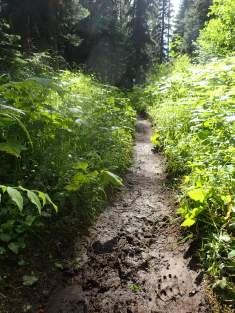
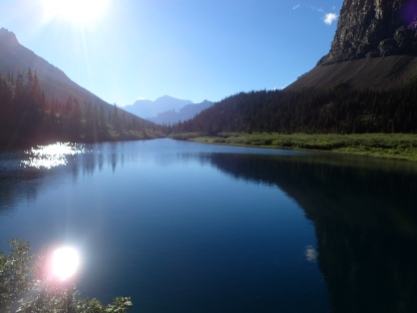



So enjoying your blog, guys. Very good writing.
I’m sure you’d like this blog of two people travelling around the most scenic wilderness areas of the States in their Kombi: http://www.idletheorybus.com (or follow on FB: http://www.facebook.com/IdleTheoryBus)
LikeLike
Oh my lord, that last tale of the breath test is too hilarious! Thanks to ranger G and to your recounting for the belly laughs I just enjoyed 😀
And I wish I could have been there to taste a Huckleberry and thimbleberry !! Beautiful tales guys!
LikeLike
Oh my gosh Moi, it was the funniest ever!! I was absolutely wetting myself! We didn’t even put half of it in there, the ridiculousness of that situation! So good 🙂
Ooooh you would have loved the berry picking! I can’t resist some good foraging, oh so fun! We ate so many that we STILL haven’t been able to eat any more on any subsequent hikes, despite finding those berries elsewhere too. The thimbleberries are really like nature’s candy – i’ve NEVER tasted a berry so sweet and flavourfull before! xo
LikeLike
Massive!
LikeLike